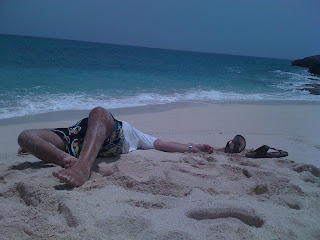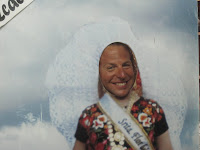Captain's Blog-Bonaire to Sint Maarten
We made it to Bonaire – safely, and very, very happily.
However, it was a sea trial in essence - we weren’t going to do a 450 nautical mile open ocean crossing at 4.5 knots with an overheating transmission. And the bilge/shower pumps needed to be fixed.
That’s how Jeff went from passenger to crew.
Jeff masterfully replaced the two bilge pumps and float switches that had somehow simultaneously malfunctioned. On a new island, with new eyes, we examined the transmission. We poured over the shop manual.
* NOTE* This next part will be technical, and probably boring, for most, but I will try to explain it in terms that I (and everyone else) understands.
The manual advised changing the angle of the oil cooler – Kenneth (Aruba mechanic) and I had changed its angle in our attempts to diagnose the gear issue, so maybe this was the problem.
It also advised that the transmission cooler be the first to be cooled by “raw” (ocean) water, but, on H2, it was the last – after coolers for the engine, stabilizers, and thrusters.
We (read: Jeff) changed the angle of the cooler and rerouted the raw water so that the transmission came first.
Sea trial!
But it wasn’t a good one – nothing failed, but nothing worked either. The transmission still ran too hot.
I was done. I had already been in touch with the company that supplied parts for the transmission when we were in Panama, so I asked them if they had a “drop-in” replacement. And they did . . . if we shipped our transmission to them first (read: they didn’t have one, but they could rebuild ours). It didn’t instill confidence, but we were pretty much out of options.
Sam and I went to the local shipping company, the best (and only) of Bonaire. They didn’t know if they could ship something 150 pounds to the US. I asked what the weight cutoff was for fedex, and was told “150”.
I said we could take it apart and ship it in pieces, at which point I was asked for my phone number so they could tell me a price – but I was told it might be a week until I heard back from them. I never heard back from them. Standard island stuff.
We looked for someone locally who could rebuild a transmission, and finally found one – and he conveniently worked at the marina we were marooned at. It wasn't easy telling Jeff that we’d have to pull the transmission, but I did.
And he resisted. Something about pressure, diagnosing the problem – so we tried again. He, NAPA, and “Boomerang” (another hardware store) built a gauge that could determine the pressure in the transmission.
Sea trial!
Apparently, we had enough pressure to make the cooling system work at 1500 RPMs when the transmission was cold. Once it got hot, the transmission fluid got too viscous (watery) to create pressure.
We still didn't have a solution though.
So I’m awake in the middle of the night (as I often am) and, due to a lack of wifi, I couldn’t stream Law & Order (what I normally do at 2 AM when I can’t sleep).
The only thing I have to read was the shop manual for the transmission
.
At this point, I had read, and re-read, this manual at least 30 times. But apparently, that wasn’t enough.
This time, I noticed a passage in the manual that read. . . .
Basically, it said that in engines that run under 3000 RPMs (H2 does 2200 max) standard 30 weight oil is okay.
And the kicker, IN HIGH TEMPERATURE ENVIRONMENTS, 40 WEIGHT IS ACCEPTABLE.
I don’t know what “weight” means, except that the higher the number, the thicker the oil. Therefore, the less viscous. Therefore, it would be less likely to lose pressure and cause our problem.
If there is a high temp environment for Krogens, it’s the Caribbean – the majority of these boats are in either the Chesapeake (cold) or the Pacific Northwest (friggin’ freezing). Both have water that is at least 20 degrees colder than the Carib.
I showed that part of the manual to Jeff the next morning. He had had similar thoughts – not because he read the shop manual over an over, but because he understood what pressure and viscosity meant (I’m still not sure if I know that). Or at least he claimed to.
The guy who was going to rebuild the transmission came by. We told him the idea – not using transmission fluid, but using standard oil – and his response: “Yeah, we don’t use ATF (automatic transmission fluid) here – we use 30 weight.”
A good sign.
Sea trial #3 (on Bonaire).
SUCCESS.
And we got to meet the Coast Guard, who boarded and searched our boat – always a fun experience.
It was time to go.
(This next part took place over 10 months ago. I haven’t been able to think about it, nonetheless talk or write about it, until now – and I’m not sure I’ll get through it. It’s as if the events gave me PTSD, to be honest.)
We left the following day. According to the marine forecasts, the sea conditions would be less than ideal, but they probably wouldn’t calm down for a few months – our weather window was long gone, and things would only get worse, so it was time to go.
We ran at 1600 RPMs to start - engineer’s orders. I asked him why, and he replied, “mechanical sympathy.”
Ironically, he used the same term to explain why we should run at 1800 RPMs on the way down Baja – that was sympathy for the stabilizers though, not the transmission. When I pointed this out to him, he simply replied, “I’ve been on a Coast Guard helicopter – do you want to go on one too?” I asked if he thought Monty and Mazie would enjoy the ride. He told me the Coast Guard doesn’t pick up dogs.
I sat down with them both (Monty and Mazie) and promised I wouldn’t leave them under any circumstances – if the Coast Guard wouldn’t take them, they wouldn’t be able to take me either. It was a very emotional conversation, and while I’m pretty sure they didn’t understand, they definitely enjoyed licking the tears off my face.
And then . . .
I’m not sure when exactly, but at some point it was noticed that our RPMs were decreasing, and pushing the throttle did nothing to help.
Jeff and I both knew what the problem was – clogged fuel filter. Normally, this wouldn’t be that big of an issue. You shut down the engine, change the filter, bleed the air out, and you’re on your way. However, when you’re 100 miles offshore, you don’t want to shut down your only engine unless you absolutely have to – too much can go wrong. The starter could fail, but the big issue for us was that the battery might not have enough juice to start the engine.
(a digression)
Oh, I forgot to mention the power situation on Bonaire. Apparently Bonaire has an 110v/50hz system. It is probably the only place in the world that does – usually it’s either 110/60 or 220/50. All of our 110-125v equipment (A/C, freezer, washer/dryer) is designed for 60 hertz. What’s the difference? Apparently, motors don’t spin as fast and so they get hotter and are more prone to failure. I can’t explain it – I’d think a slower motor would run at a lower temp, but electricity is a mystery to me.
We found this out when I noticed the A/C was acting funny and I asked the marina staff if they were having power issues. They weren’t. We were.
Anyway, Jeff said we probably shouldn’t run the washing machine.
But Jeff, to my knowledge, had never been a small appliance repairman, and I needed clean underwear. I dismissed his concerns (after all, the difference between 50 hz and 60 hz is only 10 hz – 1/5th or 1/6th of the total) and we ran the washer. Until it stopped.
Having known about the island power issue, I thought we should try the generator – it ran at 60 hz. So we started up the generator, and it purred like a kitten.
But when I switched power over to it (from shore power), nothing happened. The engine was running, but it wasn’t kicking out any volts.
Did I mention that the freezer stopped freezing too?
So we were without a washing machine (no big deal), a freezer (mmm . . . kind of important), and a generator (VERY IMPORTANT).
(end digression)
Changing a fuel filter is fairly easy – it’s the bleeding that can get complicated. You basically have to crank the engine multiple times until the air bleeds out – a major strain on the batteries.
Normally, this wouldn’t be a big deal – we’d run the generator to make sure the batteries got charged. But we didn’t have a working generator.
I asked Jeff for advice, and he said, “You’re the captain.”
So, as captain, I slept on it.
Until the stabilizers went out, 200 miles offshore.
Stabilizers, like an autopilot, are a luxury, but a necessary one. We went from pitching 10 degrees to pitching 40. Fortunately Henrietta II is self-righting to 80 degrees, but 40 feels a lot like 80 when you’re offshore.
Also, it meant our 2 hours on watch/4 hours off shifts would be no more – now we had two hours on, two hours holding Monty (poor guy has dainty paws, so he’s prone to sliding) and couch surfing, and maybe two hours of sleep.
With clogged fuel filters and busted stabilizers, I changed course to the nearest port – St. Croix. Still 150 miles away, but closer than Sint Maarten.
The engine continued to slow down – the filter needed to be changed, but I wasn’t going to stop the engine – not if it meant being rescued by a helicopter.
And then we spotted a tanker. And a massive catamaran. I tried to hail them on the radio, but they didn’t respond. Still, they were within sight. It was time to change the filter.
We did a test run – lifejackets on, turned the boat in to the waves, and experienced what it would feel like.
Then we did it for real. Well, Jeff did most of it – he changed the filter, I kept the boat facing the swell, and Sam kept me from losing my mind.
The filter was changed. The engine started up. I cried (cry #2 for those who are keeping track).
But the engine still wouldn’t break 1400 RPMs.
The primary filter was clogged as well, and had to be changed.
Fortunately, I’d switched out the old . . . basically, I replaced the original filters that were tough to change with a simple spin-on.
So I shut down the engine again, Jeff changed the other fuel filter, and Sam kept the dogs and me sane again.
However, the H2 didn’t roar back to life this time. The primary filter, which should almost never need changing, needed to fill with fuel for the engine to run. And the only way to fill it with fuel is to crank the engine. And every crank used more battery.
I could hear that we were losing battery power quickly.
I called out a Pan-Pan on the radio, the last thing you do before a “Mayday” call.
No one answered, of course.
After a few tense minutes, Jeff was able to bleed the system, the boat started, and we were on our way. Tears were shed (cry #3), and hugs were shared.
I can’t describe how frightening the entire passage was. It was the scariest thing I’ve ever experienced, and something I will never do again.
We made it to St. Croix. A white guy with dreads was able to fix the stabilizers in less than an hour (“Dude, you blew an o-ring! I’ll put a stronger one in!”). Jeff could use his phone. They had a Sears. And a brewery. And a lot of mongoose. I had one of the funniest and most memorable experiences of my life, but unfortunately I can’t write about it for legal reasons.
Jeff met a person who he could only describe as, “the highest man on earth,” while doing laundry.
We waited for our weather window, and it arrived about a week later.
On our way out of the marina, the guy on the boat next to us was power-waxing. I couldn’t hear Sam’s instructions, so I yelled, “I can’t hear you over that (explitive) guy’s waxing.”
The waxer stopped, turned, and asked where we were headed. ‘Sint Maarten,” I replied.
“Porto Cupecoy has a great deal right now – like $10 a foot.”
I didn’t believe him. We had visited Porto Cupecoy, and there was no way they’d charge only $10 a foot. There were 4 restaurants, a grocery store, awesome infinity pool, and beach within walking distance. Every other marina wanted at least $18.
And when Jeff told me that the waxer was the “highest man on earth,” I dismissed the possibility outright.
Due to a great weather window and very poor planning, we arrived in Philipsburg, Sint Maarten at 3 AM.
We made it. I mistook a moored tug for a buoy, but otherwise, for a 3 AM arrival at an unfamiliar port, we did quite well.
The next morning I was awakened by the Coast Guard for another boarding and inspection. It was our third, and, interestingly, all three took place near Dutch islands by the Dutch Coast Guard. I guess they’re the only coasties who aren’t afraid of dogs.
We quickly realized that the marina in Philipsburg wasn’t going to work out – the daily parking fee exceeded the slip fee.
So we went exploring, and to humor ourselves, went to Porto Cupecoy to see if “the highest man on earth” was right.
He was. $1 off, but close enough.
Sam had to start work almost immediately, so Jeff and I moved the boat from Philipsburg to Porto Cupecoy. Porto Cupecoy, like most marinas on Sint Maarten, is inside the Simpson Bay lagoon, and you need wait for the bridge to open to get in. For $1000 they’ll open it for you whenever you want, but otherwise . . .
I’d never been through a drawbridge before. It wasn’t very exciting, but seeing my future bosses at the Yacht Club celebrating our arrival felt good.
Sam, Mazie, Monty, and Mitch (dockmaster) escorted us in. We were home.



Comments
Post a Comment